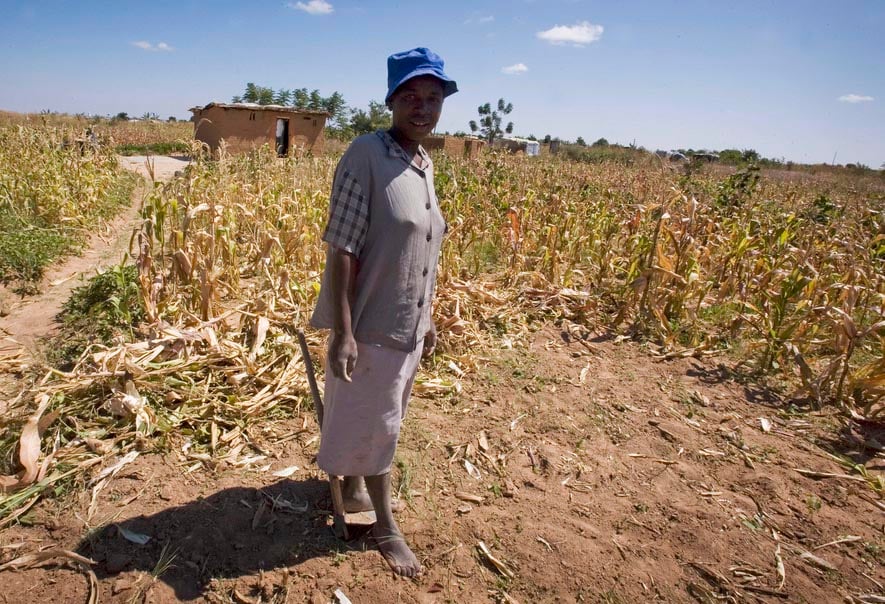With the help of his three teenage grandsons, he began tilling his 12-hectare plot. However, two weeks later the rain had stopped and the planted seeds had not germinated. Then temperatures began to soar.
"Unlike in the past when we knew the middle of September signalled the beginning of serious farming activities, it is now extremely difficult to tell when you should start planting," Musonza told IRIN.
He has had poor yields in the past three years. The lack of fertilizer and prolonged dry spells have not helped.
In 2009 the rain started in early November in his area and then stopped around mid-December only to return in the second week of January 2010, but it did not develop into a steady downpour.
Musonza is by no means the only farmer struggling to plan - in the face of erratic rain - for the main farming season which runs from September till harvesting time in March.
Most small-scale farmers in Zimbabwe depend on regular rainfall patterns, and this is also true of commercial farmers because much of their irrigation equipment was either vandalized or stolen at the height of the land redistribution programme in 2000.
"It is no longer possible to predict with accuracy when to start planting and in most cases, farmers end up replanting," Denford Chimbwanda, president of the Grain and Cereal Producers Association (GCPA), told IRIN.
In its report to the UN Framework Convention on Climate Change, the Zimbabwean government said it expected climate change to affect the main staple crop, maize, cultivation of which might have to be abandoned in some low-lying southern areas.
“Forced to gamble”
He said his office was designing a national adaptation framework: Projects had been launched in selected rural areas to assess the level of vulnerability among farmers, and to educate them on how to adapt to climate change. "The level of awareness regarding climate change is still very low.”
GCPA’s Chimbwanda said the government's failure to educate farmers on how to adapt to changing weather patterns meant farmers did not know which seed varieties to use. "Farmers are forced to gamble because they do not know whether to plant long-season seed varieties or short ones."
Chimbwanda has been urging farmers to plant drought-tolerant small grains such as millet, but admitted that because most people have traditionally grown maize, the idea had not yet caught on.
Climate change is expected to pose a serious threat to maize production, said a September 2009 report by the Governance and Social Development Resource Centre (GSDRC), a UK-based consortium of 12 organizations. It said declining maize yields would affect agriculture-based industries and the economy as a whole. The report also noted that little research had been carried out on climate change in Zimbabwe in the past five years.
Self-help initiatives
With relatively few government-funded agricultural programmes, some self-help initiatives have begun to take root in Zimbabwe.
Kuziva Chiriga - a 62-year-old village head, former school teacher and part-time farmer - lectures residents of his village (about 50km south of Harare) on climate change after himself benefiting from an NGO awareness-raising programme.
Chiriga teaches villagers about crop diversification methods and soil conservation, but preparations for the 2010-2011 farming season are in disarray because of unpredictable rain and the lack of inputs.
"Most of the villagers here say they do not have the money to buy enough seed and fertilizer," said Chiriga. A 25kg bag of maize seed costs about US$25 and the same quantity of fertilizer about $40 - prices considered exorbitant by the villagers.
Government efforts
The Ministry of Environment is running some programmes to help people to adapt to poor rains. One such programme in Mashonaland East Province taught farmers about rainwater harvesting and farming methods which have helped boost yields, said the ministry's Zhakata.
"We are encouraging farmers to go back to traditional safety nets such as `zunde ramambo’ [farming, harvesting and storage of crops for collective use by communities] and intercropping… The government is also revising school curricula to ensure that students learn about climate change from the primary level to college," said Zhakata.
Dry spells in the latter half of the 2009-2010 planting season have compromised food security, according to the Famine Early Warning Systems Network (FEWS-NET). At least 600,000 people are the beneficiaries of food aid programmes as of October 2010.
fm/jk/cb
This article was produced by IRIN News while it was part of the United Nations Office for the Coordination of Humanitarian Affairs. Please send queries on copyright or liability to the UN. For more information: https://shop.un.org/rights-permissions





